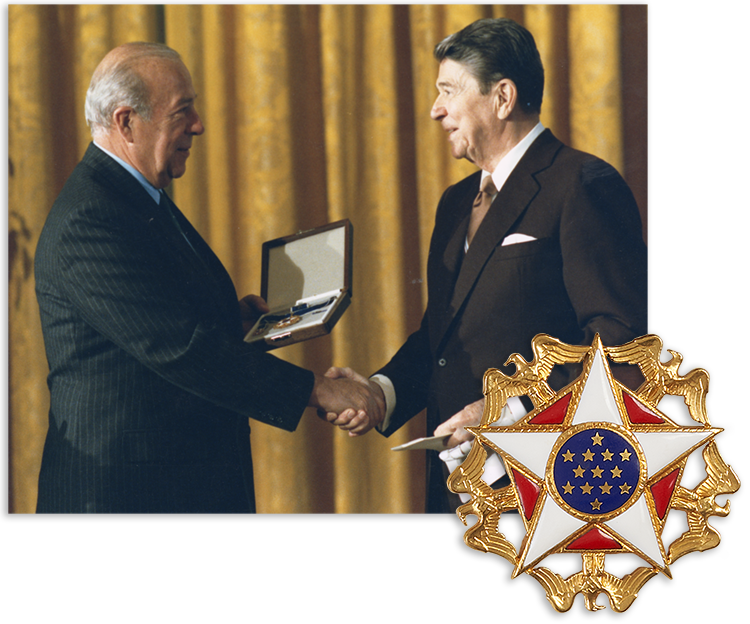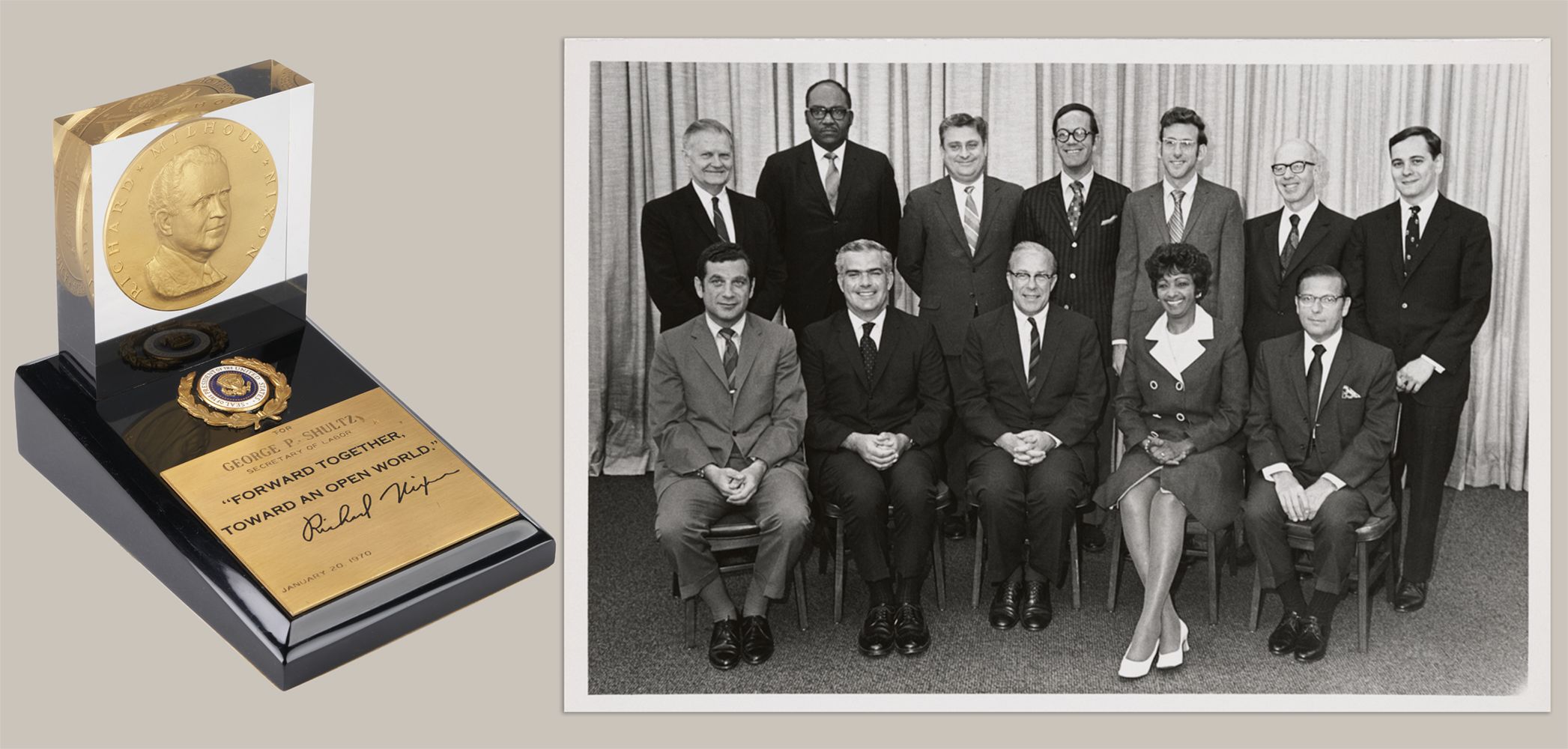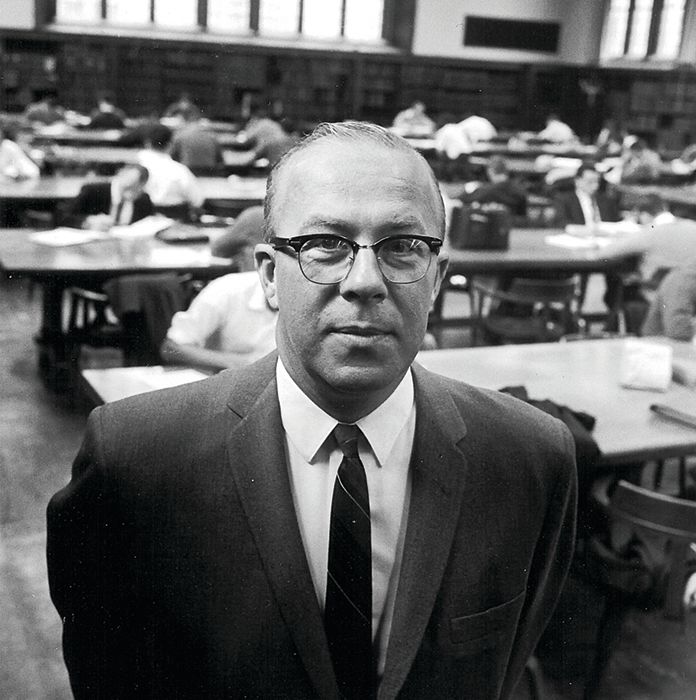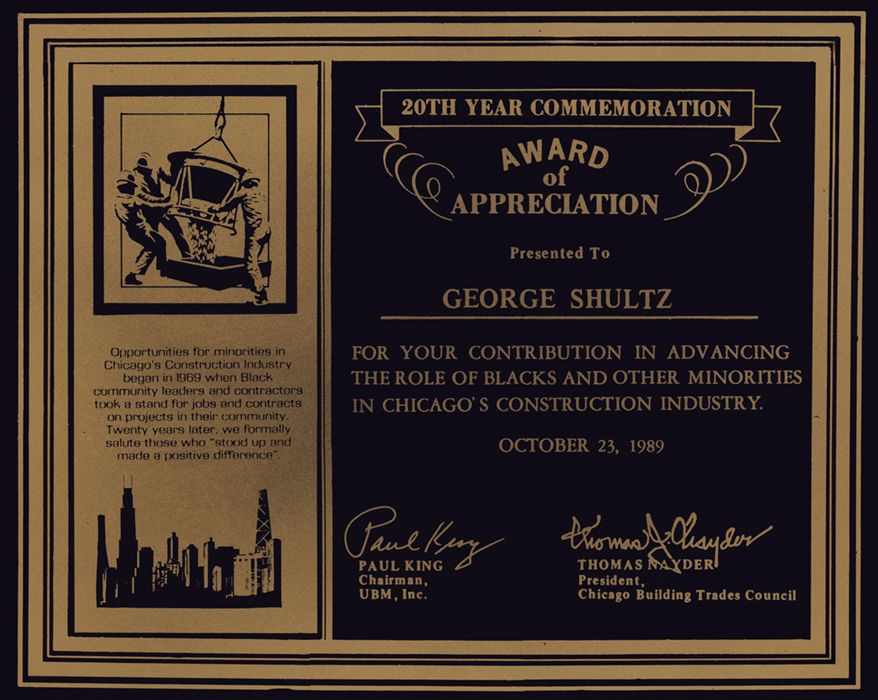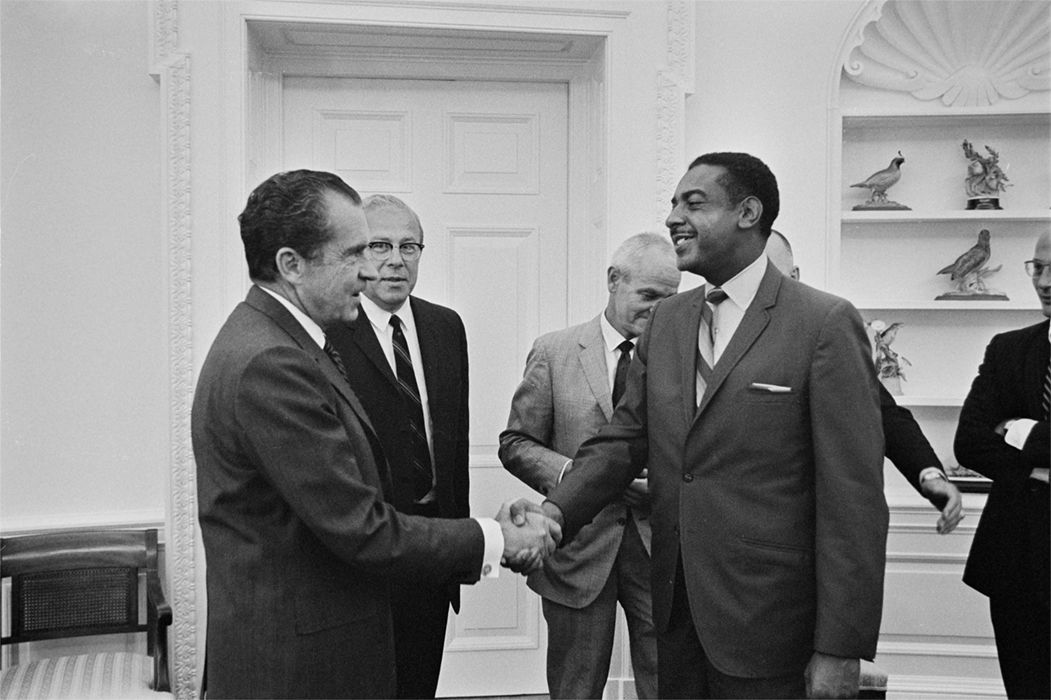George P. Shultz
Statesman and Humanitarian
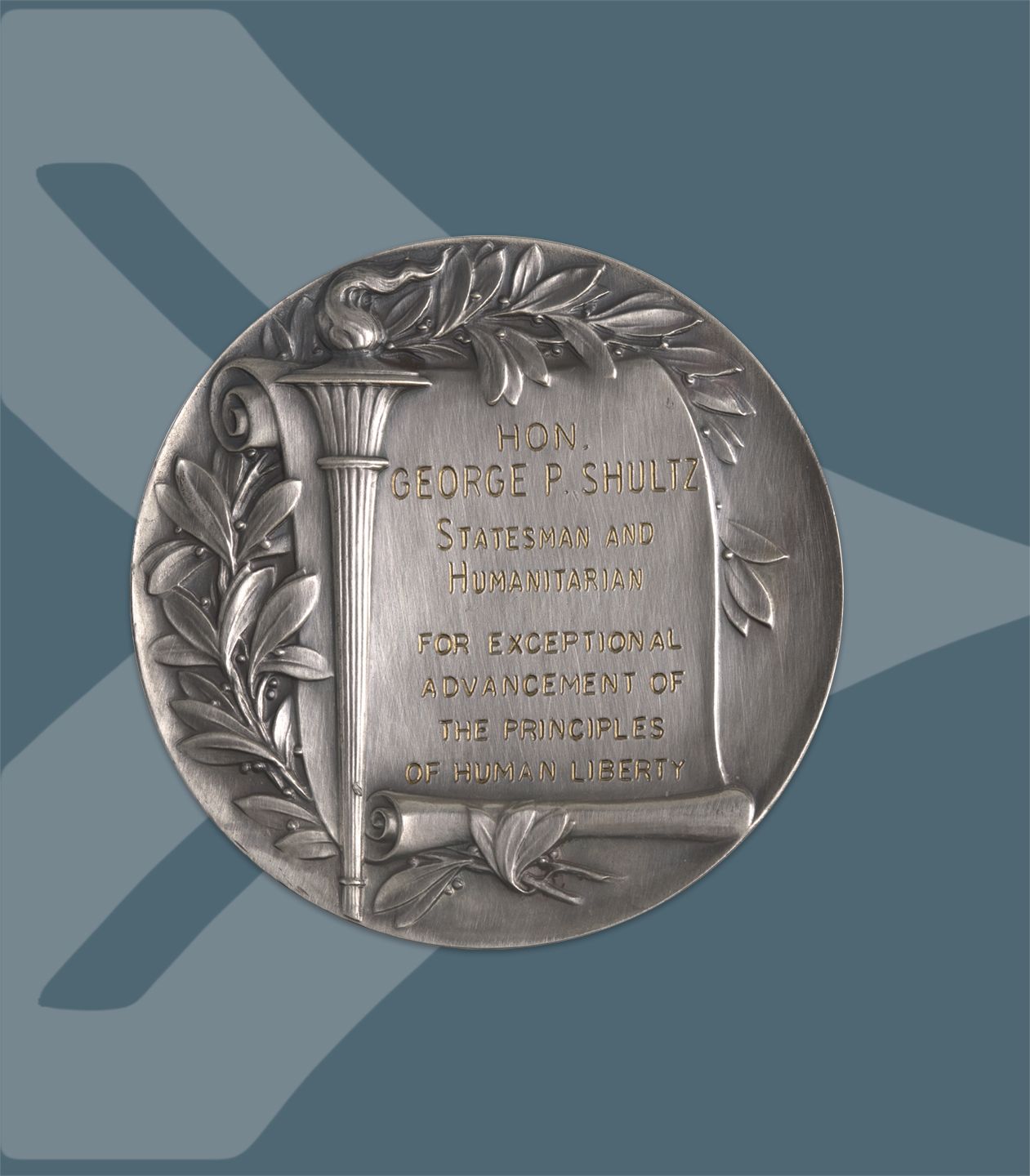
George Pratt Shultz (1920–2021) was a natural problem solver who was raised to treat people based on their merits, not their race or creed. He had a strong commitment to human liberty and the inalienable rights of all people.
Over the course of the Nixon and Reagan presidential administrations, Shultz’s effective leadership in pursuit of civil rights nationally and human rights globally resulted in some of the finest achievements of his lifetime. They are reflected in the George P. Shultz papers at Hoover, which are filled with the most humanitarian awards of all the collections—a fitting testament to a life lived in service.
George Shultz receiving the Medal of Freedom from President Ronald Reagan, January 18, 1989, and a detail of the Medal of Freedom. George P. Shultz papers, Hoover Institution Library & Archives
George Shultz receiving the Medal of Freedom from President Ronald Reagan, January 18, 1989, and a detail of the Medal of Freedom. George P. Shultz papers, Hoover Institution Library & Archives
CIVIL RIGHTS
George Shultz watched from Chicago as the civil rights movement laid bare the division within America. As a labor economist, he knew the practical advantages to ensuring equal opportunities for all Americans. Morally, he found discrimination repugnant and felt people should be treated on their merits. A 1962 direct encounter with the ugliness of racism left a deep impact on Shultz, who later reflected:
“Intellectualizing about the issue is one thing. Having it happen to you is something else again. You get it in your stomach in a way that is different from getting it in your head.”
Shultz championed civil rights quietly. At the University of Chicago Graduate School of Business, he established the Careers for Negroes in Management program in 1964—his proudest achievement as dean. As part of the Nixon administration, Shultz took the lead on restructuring the Job Corps, increasing contracts with minority-owned construction firms, alleviating discrimination in the building trades, implementing court-ordered integration of school systems in the South, and reforming welfare. Critically, he successfully guided federal affirmative action programs through Congress and the courts—something past administrations had failed to achieve.
Recognition award given to President Nixon's Cabinet members at a private dinner on January 20, 1970 (left) and a photograph of the Department of Labor staff, with Secretary of Labor George Shultz seated at center, circa 1969, George P. Shultz papers, Hoover Institution Library & Archives
Recognition award given to President Nixon's Cabinet members at a private dinner on January 20, 1970 (left) and a photograph of the Department of Labor staff, with Secretary of Labor George Shultz seated at center, circa 1969, George P. Shultz papers, Hoover Institution Library & Archives
George Shultz, dean of the Graduate School of Business (1962–68), at the University of Chicago library, circa 1962. George Pratt Shultz Papers, Hoover Institution Library & Archives
George Shultz, dean of the Graduate School of Business (1962–68), at the University of Chicago library, circa 1962. George Pratt Shultz Papers, Hoover Institution Library & Archives
20th Year Commemoration Award of Appreciation presented to George Shultz by UBM, Inc. and Chicago Building Trades Council, October 23, 1989. George P. Shultz papers, Hoover Institution Library & Archives.
During his time in Chicago, Shultz worked on advocating for equal economic opportunities for all people. He also collaborated with corporations and unions to expand job opportunities for African Americans: for example, working to find systemic solutions for the thousands of employees left behind when the meatpacking industry left the city; and launching a program to increase the number of Black students admitted to the business school.
“I am deeply interested in civil rights matters and feel the Department of Labor can—and should—play a significant role in assuring equal opportunities to all Americans.”
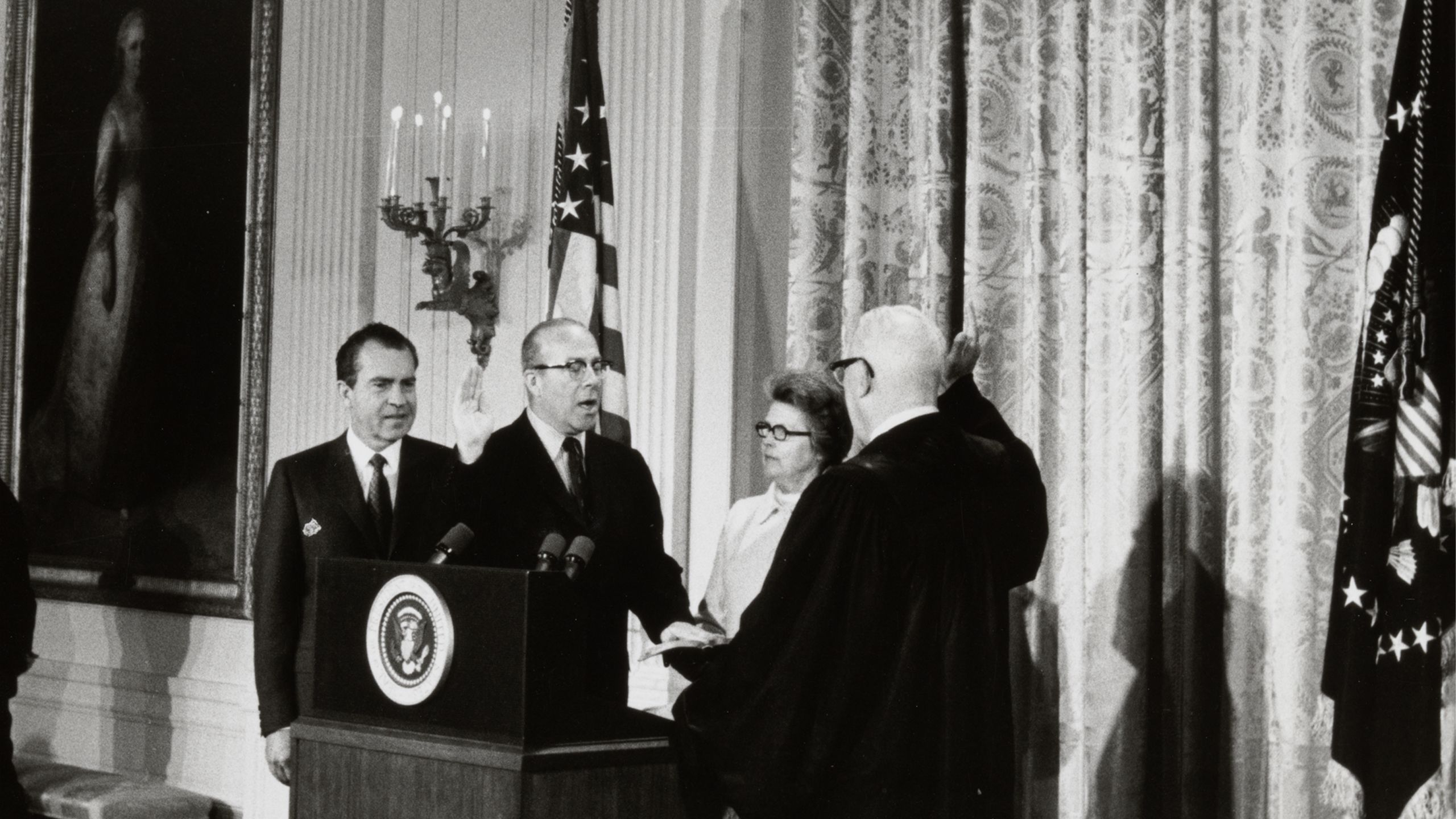
Secretary Shultz on Desegregation
By 1970, Alabama, Arkansas, Georgia, Louisiana, Mississippi, North Carolina, and South Carolina continued to defy the Supreme Court’s 1954 decision in Brown v. Board of Education of Topeka, which declared dual school systems unconstitutional. These states were also in defiance of a 1969 Supreme Court decision ordering an end to any further delay.
In March 1970, President Richard Nixon declared Brown to be “right in both constitutional and human terms” and expressed his intention to enforce the law. Secretary of Labor George Shultz described his role as the de facto chairman leading a cabinet committee to manage school desegregation:
“We formed biracial committees in each of the seven states. The first group to come to Washington was from Mississippi and a pattern was repeated when groups from the other states came in:
The discussion was civil, but deep divisions were evident. I let them argue and get it out of their systems. Then it was time to shift gears. By prearrangement, I had Attorney General John Mitchell standing by. He was known throughout the South as the tough guy, and was regarded by the whites as “their man.” I asked Mitchell what he planned to do. “I am attorney general, and I will enforce the law,” he growled in his gruff, pipe-smoking way. He offered no judgments about whether this was good, bad, or indifferent. Then he left. No nonsense.
So I said to the group, “The discussion we’ve had this morning has been intense and revealing, but you can see that it’s not really relevant. The fact is, desegregation is going to happen. You have a great stake in seeing that this effort is managed in a reasonable way, whether you like it or not.”
President Nixon greets a Georgia State Advisory Committee member in the Oval office, August 6, 1970. White House Photo Office, National Archives and Records Administration (Roll WHPO-4098).
President Nixon greets a Georgia State Advisory Committee member in the Oval office, August 6, 1970. White House Photo Office, National Archives and Records Administration (Roll WHPO-4098).
Chairman Shultz’s Working Agenda for the Meeting with State Advisory Chairmen and Vice Chairmen, August 14, 1970. George P. Shultz papers, Hoover Institution Library & Archives
Chairman Shultz’s Working Agenda for the Meeting with State Advisory Chairmen and Vice Chairmen, August 14, 1970. George P. Shultz papers, Hoover Institution Library & Archives
Middle School map
Mobile County School District
1970 August 28
George P. Shultz papers, Hoover Institution Library & Archives
Mobile County (Alabama) exemplified some of the issues that arose from school integration. The combination of school district gerrymandering and school pairing often burdened families with long distances to get their children to school.
One example of gerrymandering includes the diagonal districting of Washington. Imagine living in the southeast of the Washington segment and having to trek across the city to get to middle school instead of traveling a few streets to the Eanes Middle School.
The same can be said for the diagonal districting of Central. Residents living in the southern part could have traveled much more easily to Hall Middle School than to Central Middle School.
The Philadelphia Plan Rider
To accomplish their goals on affirmative action, Secretary of Labor Shultz and Assistant Labor Secretary Arthur Fletcher chose to modify the Johnson-era “Philadelphia Plan,” requiring federal contractors to practice nondiscrimination in hiring. They announced that the new plan would set race-based hiring goals and timetables but no hard quotas for integrating the building trades. Shultz saw quotas as inexpedient: “There’s been a quota system in place for a long time, and it’s been very effective. Zero: that’s the quota.” The rider passed, allowing the continued implementation of the plan, which would soon set a precedent for similar initiatives.
Secretary of Labor George P. Shultz shaking hands with the Assistant Secretary of Labor Arthur A. Fletcher. George P. Shultz papers, Hoover Institution Library & Archives. — Fletcher has been widely referred to as the "father of affirmative action" due to his contributions to the Revised Philadelphia Plan. Later, he would become chairman of the US Commission on Civil Rights (1990–93).
Secretary of Labor George P. Shultz shaking hands with the Assistant Secretary of Labor Arthur A. Fletcher. George P. Shultz papers, Hoover Institution Library & Archives. — Fletcher has been widely referred to as the "father of affirmative action" due to his contributions to the Revised Philadelphia Plan. Later, he would become chairman of the US Commission on Civil Rights (1990–93).
Two details of a photograph taken aboard Air Force One showing (left to right) President Richard Nixon, Senate Minority Leader Hugh Scott (R-Pen), Cong. Joe D. Waggonner (D-LA), and George P. Shultz, 1972. White House Photo Office, National Archives and Records Administration (194769).
Two details of a photograph taken aboard Air Force One showing (left to right) President Richard Nixon, Senate Minority Leader Hugh Scott (R-Pen), Cong. Joe D. Waggonner (D-LA), and George P. Shultz, 1972. White House Photo Office, National Archives and Records Administration (194769).
Tally Sheet of Senator Hugh Scott on Vote to Strike the Philadelphia Plan Rider to the Supplemental Appropriations Bill, December 22, 1969. George P. Shultz papers
Tally Sheet of Senator Hugh Scott on Vote to Strike the Philadelphia Plan Rider to the Supplemental Appropriations Bill, December 22, 1969. George P. Shultz papers
HUMAN RIGHTS
President Reagan’s foreign policy during George Shultz’s time leading the State Department wove together the nation’s material and security interests with moral values. Chief among those values was human rights. As the Cold War intensified before flickering out, Secretary Shultz was present not just to discuss arms control, prisoner exchanges, conflict resolution, and economic relations—he was there to seize every opportunity he had to demand basic human rights for the people who needed them.
At each meeting with Soviet counterparts, Shultz would bring this issue to the table and the Soviets would dismiss it as fodder for American propaganda. But as trust grew between Shultz and men such as Andrei Gromyko, Eduard Shevardnadze, and Mikhail Gorbachev, so too did the focus on Soviet refuseniks and their rights. Shultz was determined to convince them that actions on human rights were not a quid pro quo issue for the United States but that their own society would benefit from the better treatment of individuals.
US Secretary of State George Shultz and Soviet Foreign Minister Eduard Shevardnadze sign the Joint Verification Experiment Agreement in Moscow, 1988. George P. Shultz papers, Hoover Institution Library & Archives
US Secretary of State George Shultz and Soviet Foreign Minister Eduard Shevardnadze sign the Joint Verification Experiment Agreement in Moscow, 1988. George P. Shultz papers, Hoover Institution Library & Archives
Soviet refuseniks: Soviet citizens denied permission to emigrate; this was mainly due to ethnicity or religion, though formal reasons given included alleged sedition, knowledge of state secrets, and acting as foreign spies. They were treated as pariahs in society—losing their jobs, serving time in prison, getting exiled to Siberia, and dying without explanation—all for their desire to live openly and practice the ways of their ancestors.
Persons of Special Interest
By 1986, Shultz and Soviet foreign minister Eduard Shevardnadze had developed an understanding and Shultz began passing on lists of refuseniks, “Persons of Special Interest to the U.S.,” that the United States wanted allowed to emigrate from the USSR. Slowly, the Soviets acquiesced. The Americans carefully avoided publicly taking credit to ensure the easing of emigration restrictions continued.
One name on the lists was Ida Nudel (1931–2021). Having grown discontented with the Soviet treatment of Jews, Nudel requested to emigrate in 1970 but was denied. This launched her activism to support “prisoners of Zion,” among whom she became known as the “Guardian Angel.” She was ostracized by Russian society, lost her job, and was exiled to Siberia—all while being championed abroad by activists for Soviet Jewry.
“On October 15, 1987, I was asked, if at all possible, to be available in the afternoon for a phone call from Jerusalem. At 3:18 pm, the call came through in my office in the State Department. On the other end of the line came, “This is Ida Nuel. I’m in Jerusalem.” She paused, then said, “I’m home.” I could hardly speak for the rush of emotion I felt. This was one of the most moving moments of my years as secretary of state.
Her story was heroic even among the many tales of intrepid Jewish refuseniks. This courageous woman’s name was on the list I had given to Shevardnadze at the time of the Daniloff negotiation, and she had been present at the well-publicized seder I had attended in Moscow early in April. I had always said we would never give up our effort on Ida’s behalf but had never said anything to Ida or her sister that could mislead them. Ida gave Ronald Reagan and me much of the credit for forcing such promising change in human rights in the Soviet Union.”
Secretary Shultz and Helena “O'Bie” Shultz with Ida Nudel, Israel, October 1987. George P. Shultz papers, Hoover Institution Library & Archives
Secretary Shultz and Helena “O'Bie” Shultz with Ida Nudel, Israel, October 1987. George P. Shultz papers, Hoover Institution Library & Archives
Photograph of Secretary Shultz speaking at Yad Vashem and the Jerusalem Award in Appreciation to H.E. Secretary of State George P. Shultz, from the Yad Vashem Holocaust Memorial, May 11, 1985. George P. Shultz papers
Photograph of Secretary Shultz speaking at Yad Vashem and the Jerusalem Award in Appreciation to H.E. Secretary of State George P. Shultz, from the Yad Vashem Holocaust Memorial, May 11, 1985. George P. Shultz papers
Persons of Special Interest to the U.S. [List given to foreign minister Shevardnadze, September 19-20, 1986, and addendum list detailing what happened to those named], circa 1991. George P. Shultz papers
Persons of Special Interest to the U.S. [List given to foreign minister Shevardnadze, September 19-20, 1986, and addendum list detailing what happened to those named], circa 1991. George P. Shultz papers
George and Helena Shultz meeting with Russian dissidents in Jerusalem, including Alexander Lerner and Yosef Begun. An empty chair symbolized Yuli Kosharovsky, who was still refused permission to leave the USSR. By the Jerusalem Post, circa 1988. George P. Shultz papers, Hoover Institution Library & Archives
George and Helena Shultz meeting with Russian dissidents in Jerusalem, including Alexander Lerner and Yosef Begun. An empty chair symbolized Yuli Kosharovsky, who was still refused permission to leave the USSR. By the Jerusalem Post, circa 1988. George P. Shultz papers, Hoover Institution Library & Archives
The Seder of Refuseniks
On the evening of April 13, 1987, Sec. Shultz and his wife joined a small group of Russian Jews assembled for a seder at the American ambassador’s residence, Spaso House. The New York Times reported: “Many who were at the seder had been in prison or Siberian exile for calling on Washington to put pressure on Soviet authorities to relax the emigration restrictions affecting all Soviet citizens. Mr. Shultz, an Episcopalian, wore a white yarmulke as he went to every table, shook every hand and exchanged a few words with practically everyone. He seemed in awe of these tough, cheerful, resolute men and women bearing names familiar to him from the lists he presents at every meeting with high Soviet officials.”
Secretary of State George P. Shultz talking with Vladimir Slepak during a Passover seder yesterday at Spaso House, the United States Ambassador's residence in Moscow, April 14, 1987. The New York Times.
Secretary of State George P. Shultz talking with Vladimir Slepak during a Passover seder yesterday at Spaso House, the United States Ambassador's residence in Moscow, April 14, 1987. The New York Times.
Seder Cup presented to George Shultz by the Anti-Defamation League of B'nai B'rith, April 1987. George P. Shultz papers
Seder Cup presented to George Shultz by the Anti-Defamation League of B'nai B'rith, April 1987. George P. Shultz papers
“If we are ever to live in a civilized world . . . we must not only preach the doctrine of human rights, we must learn how actually to be our brother’s keeper.”

SELECT AWARDS
This online exhibition is based on the exhibition George P. Shultz: Statesman and Humanitarian which opened in July 2024 on the fourth floor of the George P. Shultz building on the Stanford University campus. The exhibition was made possible through the generous support of the Koret Foundation, the Hoover Institution Board of Overseers, and the Hoover Institution Tad and Dianne Taube Director Condoleezza Rice.
Unless otherwise noted, all material presented comes from the George P. Shultz papers, housed at the Hoover Institution Library & Archives, Stanford University.
The Hoover Institution Library & Archives has placed copies of these works online for educational and research purposes. If you would like to use any of these works, you are responsible for making your own legal assessment and securing any necessary permission. If you have questions about this resource or have concerns about the inclusion of an item, please contact the Hoover exhibits team.
Contact Us
For more information about rights and permissions please visit
https://www.hoover.org/library-archives/policies/copyright
© 2024 by the Board of Trustees of Leland Stanford Junior University.


